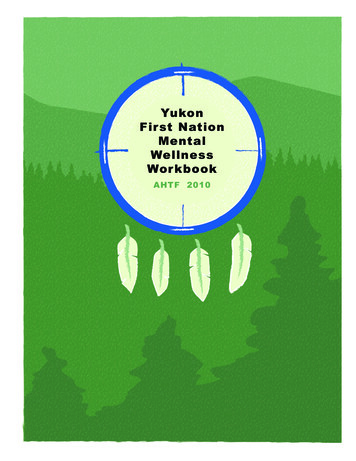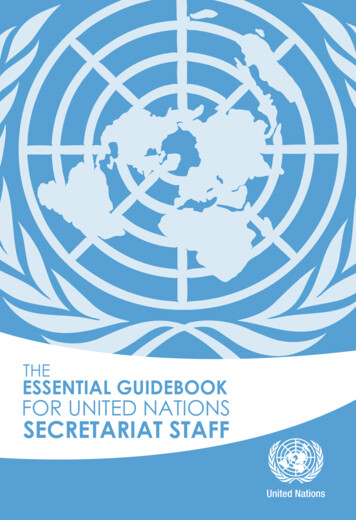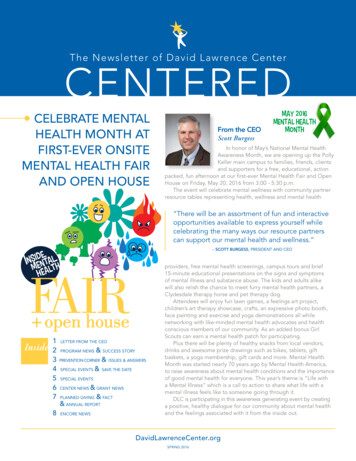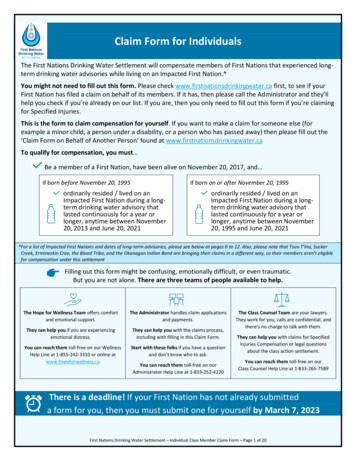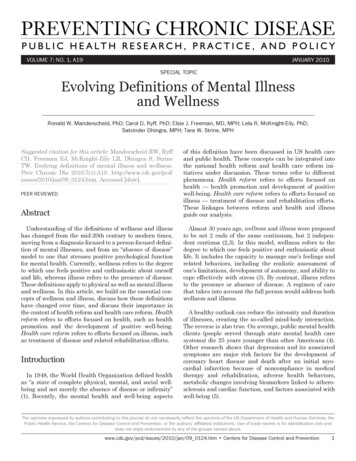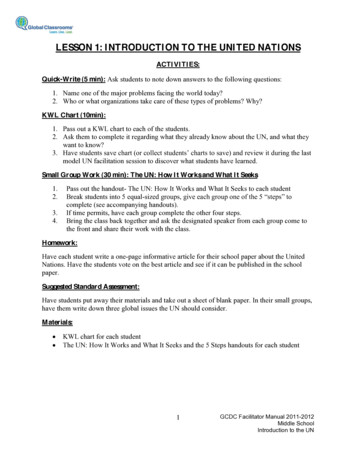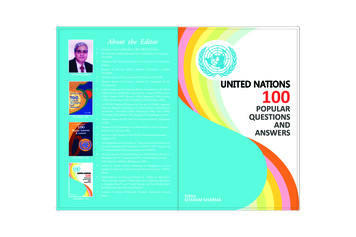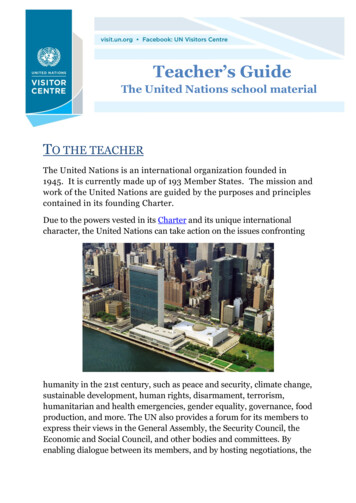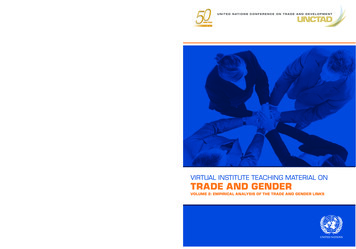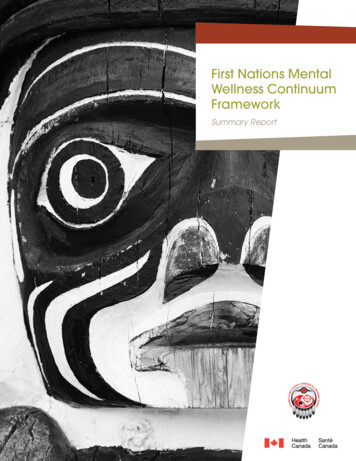
Transcription
First Nations MentalWellness ContinuumFrameworkSummary Report
Health Canada is the federal department responsible for helping the people of Canada maintain and improve their health. We assess the safetyof drugs and many consumer products, help improve the safety of food, and provide information to Canadians to help them make healthy decisions.We provide health services to First Nations people and to Inuit communities. We work with the provinces to ensure our health care system servesthe needs of Canadians.Également disponible en français sous le titre :Cadre du continuum du mieux-être mental des Premières Nations – Rapport sommaireTo obtain additional information, please contact:Health CanadaAddress Locator 0900C2Ottawa, ON K1A 0K9Tel.: 613-957-2991Toll free: 1-866-225-0709Fax: 613-941-5366TTY: 1-800-465-7735Email: publications@hc-sc.gc.caThis publication can be made available in alternative formats upon request. Her Majesty the Queen in Right of Canada, as represented by the Minister of Health, 2015Publication date: January 2015This publication may be reproduced for personal or internal use only without permission provided the source is fully acknowledged.PRINTCat.: H34-278/2-2014EPDFISBN: 978-1-100-25329-9Cat.: H34-278/2-2014E-PDFISBN: 978-1-100-25330-5Pub.: 140360
Table of ContentsIntroduction. . . . . . . . . . . . . . . . . . . . . . . . . . . . . . . . . . . . . . . . . . . . . 1Culture . . . . . . . . . . . . . . . . . . . . . . . . . . . . . . . . . . . . . . . . . . . . . . . . . 1Model and Continuum of Mental Wellness Services . . . . . . . . . . . 2Figure 1: First Nations Mental Wellness Continuum Model . . . . . . . . . . . . . . . . . . . . . . . 3Continuum of Essential Services . . . . . . . . . . . . . . . . . . . . . . . . . . . . 5Key Themes . . . . . . . . . . . . . . . . . . . . . . . . . . . . . . . . . . . . . . . . . . . . . 5Theme 1: Culture as Foundation . . . . . . . . . . . . . . . . . . . . . . . . . . . . . . . . . . . . . . . . . . . . 6Theme 2: Community Development, Ownership and Capacity Building . . . . . . . . . . 6Theme 3: Quality Care System and Competent Service Delivery. . . . . . . . . . . . . . . . . 7Theme 4: Collaboration with Partners . . . . . . . . . . . . . . . . . . . . . . . . . . . . . . . . . . . . . . . 7Theme 5: Enhanced Flexible Funding. . . . . . . . . . . . . . . . . . . . . . . . . . . . . . . . . . . . . . . . 8Moving Forward . . . . . . . . . . . . . . . . . . . . . . . . . . . . . . . . . . . . . . . . . 9Conclusion. . . . . . . . . . . . . . . . . . . . . . . . . . . . . . . . . . . . . . . . . . . . . 10First Nations Mental Wellness Continuum Framework—Summary ReportJanuary 2015
Mental wellness is a balance ofthe mental, physical, spiritual, andemotional. This balance is enrichedas individuals have: purpose intheir daily lives whether it is througheducation, employment, care-givingactivities, or cultural ways of beingand doing; hope for their futureand those of their families that isgrounded in a sense of identity,unique Indigenous values, andhaving a belief in spirit; a sense ofbelonging and connectednesswithin their families, to community,and to culture; and finally a senseof meaning and an understandingof how their lives and those of theirfamilies and communities are partof creation and a rich history.
IntroductionMental health and substance use issues continue to be apriority concern for many First Nations communities.While there are different kinds of specific mental healthissues that can affect communities, mental wellness is abroader term that can be defined as a state of well-beingin which the individual realizes his or her own potential,can cope with the normal stresses of life, and is able tomake a contribution to her or his own community.Mental wellness is supported by culture, language,Elders, families, and creation, and is necessary for healthyindividual, community and family life. First Nationsembrace the achievement of whole health—physical,mental, emotional, spiritual, social, and economic wellbeing—through a coordinated, comprehensive approachthat respects, values, and utilizes First Nations culturalknowledge, approaches, languages, and ways of knowing.Federal, provincial, and territorial mental wellnessprograms and services seek to address the indicators thatchallenge wellness in many First Nations communities;however, there are gaps in services. Further, programsand services are not always delivered in a culturallysafe manner. As a result, First Nations communitiesand leadership have been calling for the developmentof a coordinated, comprehensive approach to mentalhealth and addictions programming. In response, theFirst Nations and Inuit Health Branch (FNIHB), theAssembly of First Nations (AFN), and Indigenousmental health leaders from various First Nations nongovernment organizations jointly developed the FirstNations Mental Wellness Continuum Framework (theFramework).CultureThe cultural values, sacred knowledge, language, andpractices of First Nations are essential determinantsof individual, family, and community health andwellness. Despite the impacts of colonization, manyFirst Nations people have maintained their culturalknowledge in their ways of living (with the landand with each other) and in their language. Thesefoundations have ensured First Nations people havestrength, laughter, and resilience. Cultural knowledgeabout mental wellness does not narrowly focus on“deficits”. Rather, it is grounded in strengths andresilience. Culture is the foundation for a “good life”,and the knowledge contained within culture appliesacross the life span and addresses all aspects of life.First Nation languages, culture,and teachings are tied to the past,the present, and the future—they are thestepping stones to a brighter tomorrow.First Nations individuals, families, andcommunities have a wealth of knowledgefrom which to draw to know how to live inbalance, to care for themselves and others,and to restore balance when it is lost.First Nations Mental Wellness Continuum Framework—Summary ReportJanuary 20151
Model and Continuum ofMental Wellness ServicesThe First Nations Mental Wellness Continuum (theContinuum) is a complex model, rooted in culture andcomprised of several layers and elements foundationalto supporting First Nations mental wellness. Embeddedwithin the model are the key themes that emergedthrough dialogue with partners as well as the socialdeterminants of health that are critical to supportingand maintaining wellness. The Continuum must besupported by a number of partners at several levels,such as: Communities NationsThe model also includes a number of elements thatsupport the health system, specifically: governance,research, workforce development, change and riskmanagement, self-determination, and performancemeasurement.The Continuum aims to support all individualsacross the lifespan, including those with multiple andcomplex needs. The centre of the model refers to theinterconnection between mental, physical, spiritual,and emotional behaviour—purpose, hope, meaning,and belonging. A balance between all of these elementsleads to optimal mental wellness. Regional Entities Federal Government, Provincial and Territorial Governments, Non-government Organizations, and Private Industry.Legend (from centre to outer ring)Four Directions (outcomes)—Hope; Belonging; Meaning; and Purpose.Community—Kinship, Clan, Elders; and Community.Populations—Infants and Children; Youth; Adults; Gender—Men, Fathers and Grandfathers; Gender—Women, Mothers and Grandmothers; Health CareProviders; Community Workers; Seniors; Two-Spirit People and LGBTQ; Families and Communities; Remote and Isolated Communities; Northern Communities;and Individuals in Transition and Away from Reserve.Specific Population Needs—Intergenerational Impacts of Colonization and Assimilation; People Involved with Care Systems and Institutional Systems; Individualswith Process Addictions; Individuals with Communicable and Chronic Diseases; Individuals with Co-occurring Mental Health and Addictions Issues; Individuals withAcute Mental Health Concerns; Crisis; and People with Unique Needs.Continuum of Essential Services—Health Promotion, Prevention, Community Development and Education, Early Identification and Intervention, CrisisResponse, Coordination of Care and Care Planning, Detox, Trauma-informed Treatment, and Support and Aftercare.Supporting Elements—Performance Measurement; Governance; Research; Education; Workforce Development; Change Management and Risk Management;and Self-determination.Partners in Implementation—Non-governmental Organizations; Provincial and Territorial Government; Federal Government; Regional Entities; Nations;Communities; and Private Industry.Indigenous Social Determinants of Health—Environmental Stewardship; Social Services; Justice; Education and Lifelong Learning; Language, Heritageand Culture; Urban and Rural; Land and Resources; Economic Development; Employment; Health Care; and Housing.Key Themes for Mental Wellness—Community Development, Ownership and Capacity Building; Quality Care System and Competent Service Delivery;Collaboration with Partners; and Enhanced Flexible Funding.Culture as Foundation—Elders; Cultural Practitioners; Kinship Relationships; Language; Practices; Ceremonies; Knowledge; Land; and Values.2First Nations Mental Wellness Continuum Framework—Summary ReportJanuary 2015
Figure 1: First Nations Mental Wellness Continuum ModelgemTrauma-informent andR isk M a n a g eProvincial and TerritorialGovernmentr eaed Tm en tof Care / Care Planninga tio ne ntr d inop mv elcefortCo oetoxdives id us A al sdd wi tict hio nsntmerkWoerFedoal Gentrc areDleDeC la nHopeyitmunComrkersWoSeniorsca bI n di v id u a l s w it h C o m m u nia nd C h r o n i c D i se a s esIn coPrEducationLea and Lifrnin elonggYouthMeaningKinshipFCo amim liem saun nTwitie dsPeoo-SpirLGB ple itTQ andalthHeionmotProinationetermf-dleS, Prevention, Commun ce er nsPerformnityanDevceelopI nd i v i d u aMmeM e n t a l He ls w i t hnta lt h AcC o pihsKindanA ft eEl dersmrnvee, ureag CultugLan e anditagrHeUrban and Rural(titacrlPa naCULTUREersioneMan dGender–Men,dFathers anrsatdfGran heGender–MothWomen,eGrand rs andmothersionEducatLRe andsou andrcesangortaChppCommunityeosrpPuSuun rr i nIs s guessultAdgginlonBeandRemotedIsolate unitiesCommCrisPeinls ndua n aivid itio mInd rans y fro eT wa ervA esRNortheCommurnnitiescc- o ioC o ic ti th ddl s w and Ad uaI n d i v i H e a l thlM e n talntameer n sgov tionNon- nizaOrgaicom ntEconlopmeDevegEnhanced Flexible Fundindts anInfan renChildCrsisiInt e rg en e r atColo niza ti on i on a l Imand A p as s im c t sila o ft ioni thpl e wPeo ue NeedsqiUnSNationsReseaHP earov lthide Cars reEndIdentification and InterveEarlyntioneh Care Systemsrchonsd w itspolve tional SystemsReuIn vle nstitisop nd Intmeerionsuca teadulcia esSo rviceGovernancere, Land and Values)wledge, Knoniesd Competent Semostem anrviceerere SyD el,Cy CaiveesryalitticQuacJusticePre,agRegional Entitiest, Ownership eng(LCogSnitestwauanardsh lHoguipseitiunCommCollabosration with PartnerFirst Nations Mental Wellness Continuum Framework—Summary ReportJanuary 20153Elders,Cultura
The systems approach toaddressing care is inclusive of thefull range of services, supports, andpartners who have a role in addressingmental wellness issues among FirstNations people. This includes, forexample, First Nations communitybased services and supports but alsoother related partners and jurisdictions(e.g., housing, education, employment,and federal correctional services).It is recognized that no single sectoror jurisdiction can support individualsand their families alone. A systemsapproach provides a frameworkthrough which all services, supports,and partners can enhance the overallcoordination of responses to the fullarray of risks and harms associatedwith mental wellness issues amongFirst Nations.Honouring Our Strengths
Continuum of Essential ServicesA full spectrum of culturally competent supportsand services is necessary to support mental wellness.This continuum includes: Health Promotion, Prevention, CommunityDevelopment, and Education Early Identification and Intervention Crisis Response Coordination of Care and Care PlanningIt is recognised that not all of these services willbe available in every community; but, throughcollaboration and comprehensive planning, allcommunities can have access to key services. Byidentifying the key services, it is possible to identifygaps and avoid duplicating services that are alreadyavailable within the community, an adjacentcommunity, or from the provincial or territorialgovernments. Detox Trauma-informed Treatment Support and AftercareKey ThemesDuring regional discussion sessions, the NationalGathering, the federal discussion, and the NationalValidation and Implementation Session, several keythemes emerged that have shaped the Framework andthe Continuum. These themes are: Culture as Foundation Community Development, Ownership,and Capacity BuildingA list of Implementation Opportunities has beencreated which will provide guidance to communitiesand partners at the community, regional, provincial,territorial, federal, and national level on concretestrategies and activities for each theme. This evergreendocument will be continually updated as progressis made towards completion of implementationopportunities and as new opportunities emerge. Quality Care System and CompetentService Delivery Collaboration with Partners Enhanced Flexible FundingFirst Nations Mental Wellness Continuum Framework—Summary ReportJanuary 20155
Theme 1: Culture as FoundationFirst Nations leadership, youth, community members, andElders have made it clear that culture must be at the centreof mental wellness. Culture must not only guide our work,it must be understood as an important social determinantof health. Culturally specific interventions are holistic; theyattend to the spirit, mind, body, and emotions simultaneously.Culture as a foundation implies that all health services andprograms related to First Nations go above and beyondcreating culturally relevant programs and safe practices. Assuch, culture as a foundation means starting from the pointof Indigenous knowledge and culture and then integratingcurrent policies, strategies, and frameworks.Priorities for Action: Responding to the Diversityof First Nations Communities Defining Culture Valuing Cultural Competency,Cultural Safety and IndigenousKnowledge Understanding the Role ofLanguage in Mental WellnessTheme 2: Community Development, Ownership and Capacity BuildingCommunity development, ownership, and capacity buildingare significant factors which must be taken into accountin enhancing First Nations mental wellness. For example,community experience and research have demonstrated thepositive impact that community ownership of local programsand infrastructure can have on First Nations mental wellness.Community development, ownership, and capacity buildingwill play a key role in ensuring that the continuum of mentalwellness programs and services for First Nations are relevant,effective, and meet community needs.6Priorities for Action: First Nations Control of Services Building on Community Priorities Developing Community WellnessPlans Working Together in Partnership Investing in Community Development and CapacityBuildingFirst Nations Mental Wellness Continuum Framework—Summary ReportJanuary 2015
Theme 3: Quality Care System and Competent Service DeliveryMental Wellness depends on access to a full spectrum ofculturally competent supports and services. It is essentialthat the continuum of services be located within a qualitycare system and that the services and supports be of highquality and culturally competent. First Nations organzations,provincial, territorial, and federal governments, and other keypartners will need to work together to achieve this standard.It also requires attention to the key elements that supporta quality care system, such as performance measurement,governance, and workforce development.Priorities for Action: Delivering Accessible Services Providing Quality Mental WellnessPrograms and Services Responsiveness, Flexibility,Reliability Proactive Planning and CrisisSupports and Services Delivering Trauma-informed Care Promoting and Recognizing aCulturally Competent Workforce Providing Education, Trainingand Professional Development Supporting Worker WellnessTheme 4: Collaboration with PartnersEnhancing First Nations mental wellness requires strategicaction that goes beyond the mandate of the First Nations andInuit Health Branch. It involves other federal governmentdepartments, provincial and territorial governments, andFirst Nations communities and requires supports andservices that cross the health, justice, employment, and socialservice sectors. These partners must work collaboratively andcooperatively to ensure that a coordinated, comprehensivecontinuum of mental wellness services is available to thosewho require it. Currently, although it is recognized thatthere are shared roles and responsibilities, these roles andresponsibilities are not always clear.Priorities for Action: Defining Clear Roles andResponsibilities Establishing Leadership Creating Partnerships andNetworking Developing System Navigators,and Case Managers Providing Advocacy Raising Awareness–Reduction ofStigma and Protection of PrivacyFirst Nations Mental Wellness Continuum Framework—Summary ReportJanuary 20157
Theme 5: Enhanced Flexible FundingFunding alone isn’t sufficient to ensure a coordinated,comprehensive approach to mental wellness; however,participants in the various engagement sessionscommunicated that additional funding and the flexibilityand permanency of current funding are critical factors.The lack of adequate and sustainable funding and thecontinuous focus on project funding were identified byparticipants in regional and national discussions as harmfulto mental wellness. Currently, funding and decisionmaking that affect First Nations are siloed within multiplefederal, provincial, and territorial departments, making itchallenging to address the determinants of health and todevelop comprehensive approaches to mental wellness.8Priorities for Action: Providing Additional Funding Moving Away from Time-limitedand Siloed Funding Increasing Flexibility of FundingFirst Nations Mental Wellness Continuum Framework—Summary ReportJanuary 2015
Moving ForwardA strength of the Framework process has been itsconnection to a wide range of regional and nationalFirst Nations health and wellness networks, whichhave guided the process, shaped the Framework’svision, and supported engagement with First Nationscommunities. Specific direction for the implementationof the Framework has been developed in collaborationwith key partners who will continue to refine ideasthroughout implementation.The Framework process has helped to develop acommitment to a shared vision for mental wellness. Forsuccessful implementation, key stakeholders must takeaction within their existing resources and collaboratewith other partners. Achieving the envisioned mentalwellness continuum will require sustained commitment,collaboration, and partnerships, supported by effectiveleadership across the system. “Change leaders”, whetherindividuals or collectives (partners, teams, institutions,agencies, families, or communities), will play a keyrole. Momentum is building in several regions acrossthe country. Stronger partnerships are being developedand gaps are beginning to close in meeting the mentalwellness needs of First Nations.The Framework will guide communities to better plan,implement, and coordinate comprehensive responses tothe full range of mental wellness challenges in a mannerconsistent with community priorities. It outlines howcommunities can adapt, optimize, and realign theirmental wellness programs and services to achieve acomprehensive continuum of quality programs andservices. In addition, the Framework will supportcommunities to use existing funding in a more holisticway, informed by the essential continuum of servicesand recognizing the impact of the determinants ofhealth on mental wellness.The Framework will support conversations withmajor healthcare providers, other service providers,and jurisdictional partners to enhance collaborationand build partnerships to ensure the needs of FirstNations people are met. Strategic implementationof the Continuum depends on making the most ofrelationships with and among provincial, territorial,and federal government departments. The Frameworksupports a shift away from programming that doesn’tcommunicate or work effectively together, towarda comprehensive mental wellness system for FirstNations that is based on an evidence-based continuumof care. It provides guidance for system-level changesin the short, medium, and long term (e.g., redesigningexisting programs, re-profiling existing resources,and integrating resources across jurisdictions) thatare grounded in First Nations community prioritiesand informed by regional, provincial, territorial, andfederal government priorities. Further, the Frameworkwill guide new investments as opportunities arise.Changes over time will need to be tracked and measuredto know what progress has been made and wheremore resources and efforts are needed to fully achievethe shared goal of providing comprehensive, culturallyrelevant, and culturally safe community-based servicesto First Nations individuals, families, and communities.Monitoring progress toward achieving system changecan be accomplished through the development ofprogram and service delivery standards and indicators.Standards and indicators can, for example, provideconcrete parameters for consistent quality services whichalign with provincial and territorial systems.First Nations Mental Wellness Continuum Framework—Summary ReportJanuary 20159
ConclusionThe First Nations Mental Wellness ContinuumFramework, developed through intensive collaborationbetween First Nations partners and Health Canada’sFirst Nations and Inuit Health Branch, representsa shared vision wherein First Nations individuals,families, and communities across Canada are supportedto enjoy high levels of mental wellness. Achieving thisvision will require: Culturally-grounded community developmentand capacity building that reduces risk factorsand increases protective factors; Comprehensive, coordinated, high quality,culturally responsive mental wellness programsand services for First Nations people living onreserve; and Sustained commitment and collaborationof many First Nations, federal, provincial,and territorial partners supported by strongleadership and flexible funding.10Recognizing that a roadmap is needed to help guideand coordinate community, regional, and nationalaction, the partners have collaborated on an evergreenImplementation Plan to accompany and put intopractice the Framework. The Implementation Planidentifies urgent and actionable implementationpriorities for the short, medium, and long term. Itis expected that the list of priorities will change overtime as new issues and opportunities emerge. AsFirst Nations health organizations and federal andprovincial governments develop workplans and asFirst Nations develop community wellness plans, theContinuum, the Framework and the ImplementationPlan can serve as important resources.An important next step will be the developmentof an evaluation plan that will support ongoingimprovement in the implementation process as thepartners work toward the envisioned continuum ofmental wellness services.First Nations Mental Wellness Continuum Framework—Summary ReportJanuary 2015
the needs of Canadians. Également disponible en français sous le titre : Cadre du continuum du mieux-être mental des Premières Nations - Rapport sommaire To obtain additional information, please contact: Health Canada Address Locator 0900C2 Ottawa, ON K1A 0K9 Tel.: 613-957-2991 Toll free: 1-866-225-0709 Fax: 613-941-5366 TTY: 1-800-465-7735

